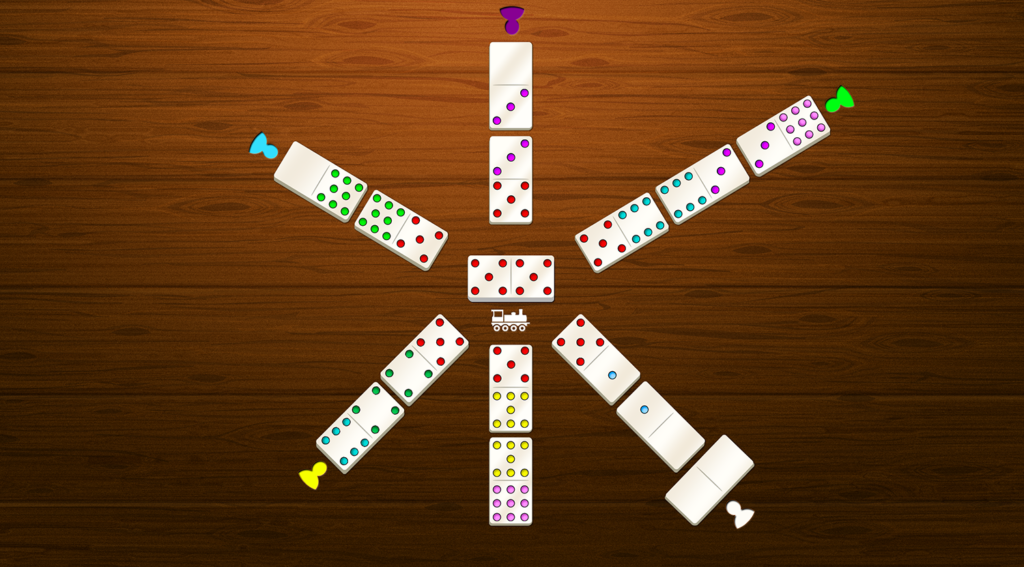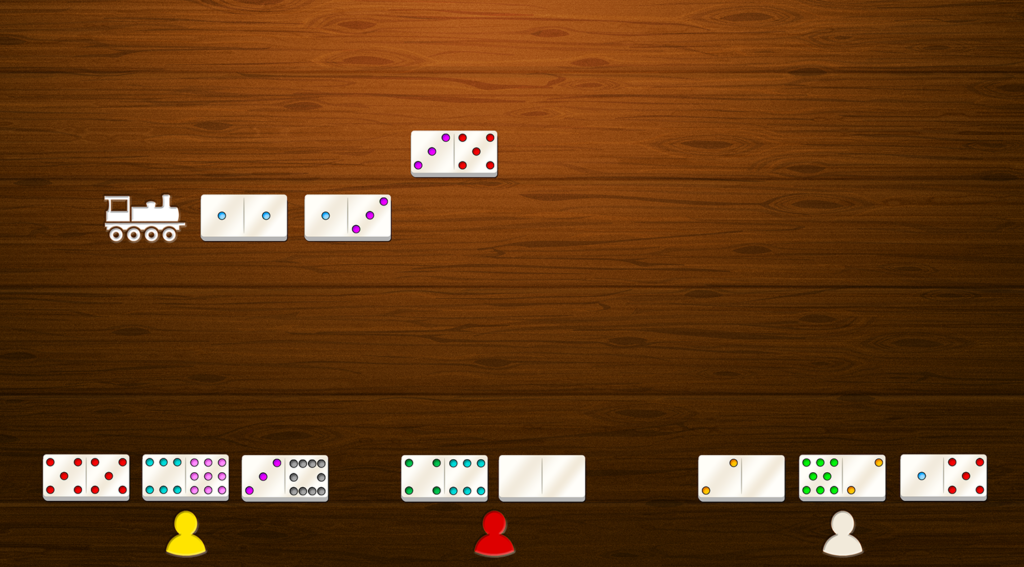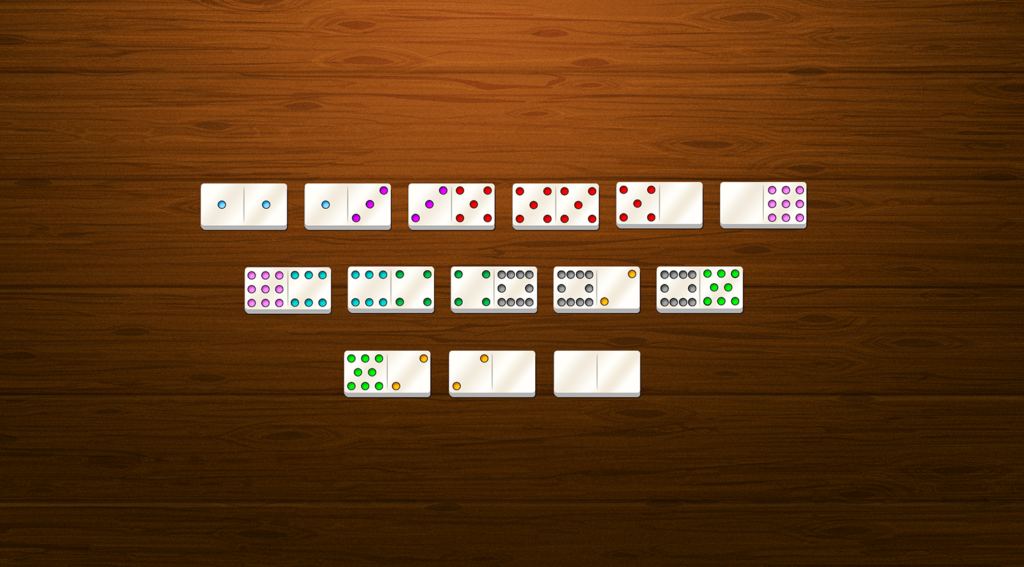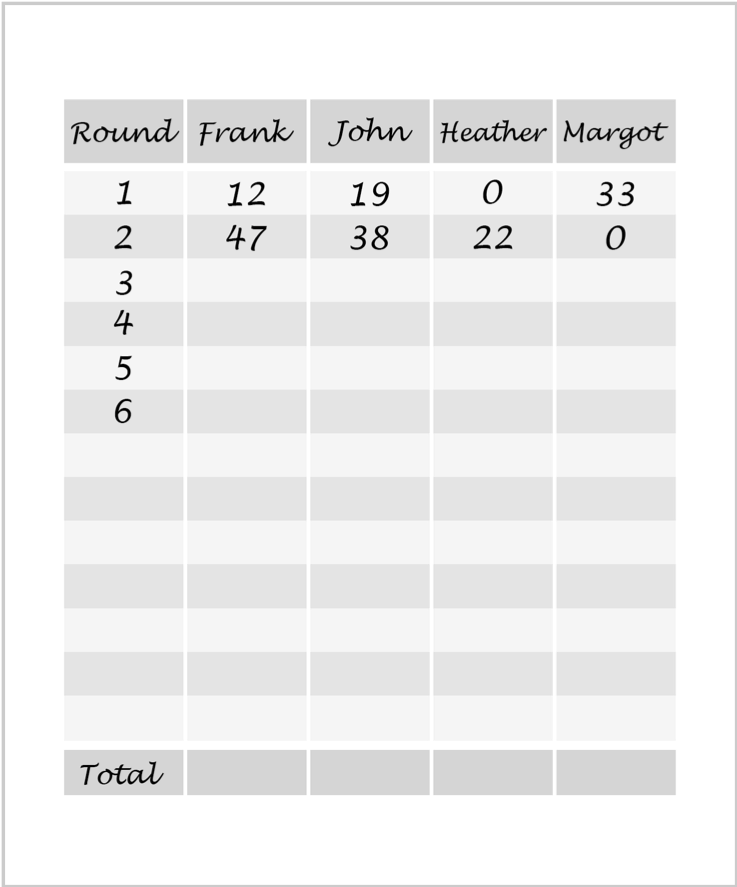
Welcome to the handiest collection of rules and variations for the classic game of Mexican Train Dominoes. We’ve also collated hints and strategies to help you play better.
In short, the game is domino-based, allowing up to 8 players and 13 rounds. To win overall, you must win each round by playing all of your dominoes. The player with the lowest score at the end of the game is the winner.
Welcome to the handiest collection of rules and variations for the classic game of Mexican Train Dominoes. We’ve also collated hints and strategies to help you play better.
Our mobile and tablet version of the game is perfect for beginners and seasoned pro’s alike, but if you want to give it a go in real life with your friends, here is the perfect place to learn how.
Find our versions of Mexican Train Dominoes here:
Rules Summary
- Each player is dealt dominoes according to the number of players and the domino set used.
- The Mexican Train is started with a double domino. It is a public train and can be added to by any player.
- Players take turns laying down single connecting dominoes to any public train or their own train.
- When a player lays down a double they must make one more move, either connecting the double or playing a domino to another train.
- If there is an open double domino at the start of a player’s turn they must either cover it or take another domino from the boneyard. An open double domino automatically makes that train public and any player can play to it. Doubles can be played in succession on any available train. This means you can leave multiple doubles for players to cover!
- If a player cannot make a move they must draw a domino from the boneyard. They can play that domino immediately if a move is available or pass on to the next player. Their train becomes public and can be played to by any other player. This is marked by placing a coin at the end of the train.
- If a player’s train is open and public and they cover it, it will return back to a private train for that player only.
- The round is finished when a player has laid down all their dominoes or there are no moves left for any player (including picking up from the boneyard). Each player adds up all the pips on their dominoes for their score which is noted. Note: Double blank dominoes are either 50 points or 0 points, depending on the agreed upon rules.
Equipment
Although the game can be played with a range of different domino sets, we find the Double-9 set works well for two or three players or a Double-12 set for four or more players. The common Double-6 set can be used for shorter games between two to four players.
Just as a reminder, a Double-6 set consists of 28 tiles, a Double-9 set consists of 55 tiles and a Double-12 set consists of 91 tiles. Domino tiles are also called bones.
You will need a pen and paper to keep score.
Setting Up and Starting
Mexican Train Dominoes can be played with any set of dominoes, but a Double 12 is most popular, which allows room for up to eight players. If playing with four or less people, a Double 9 set is recommended.
Use the table below to see how many tiles should be shared out at the beginning of the game in relation to the domino set used.
| Number of Players | 2 | 3 | 4 | 5 | 6 | 7 | 8 | |
| Tiles taken per player via set used | Double-6 | 9 | 8 | 6 | ||||
| Double-9 | 15 | 15 | 10 | |||||
| Double-12 | 15 | 15 | 15 | 12 | 12 | 10 | 10 |
After the dominoes have been distributed to players, any leftover dominoes are placed face down in the ‘boneyard’ to be used during the game (taken from the alternative name for a domino tile ‘bone’).
Allocate a score keeper, who can keep a tally over multiple rounds to determine an overall winner.
The number of rounds you play is dependent on the number of players you have. We recommend playing rounds of 3, 6 or 13, depending on how much time and how many players you have.
If you want to play a 3 round game, any double can be the starting engine, not the highest. In this case, the most common way to begin the game is via the first person who finds the Double-9 or Double-12 in the shuffled pile.
Once the length of the game has been decided, turns proceed clockwise around the table.
Variations:
Some variations say the oldest player automatically goes first, whereas others say it is the person who found the engine domino or highest double.
Play Rules
The double domino (The Mexican Train’s Engine) should be placed in the centre of the table. This can be added to by any player. Each player takes a turn to start their train, which begins by matching their tile with the pips to the Engine.
You can play solely on the Mexican train if you so wish. If you do not have the corresponding pips for the engine, you cannot start your own train, and must keep on passing and picking up until you are able to do so. All trains must begin with a domino with corresponding pips to the Mexican Train.
Each player has their own train which they can develop unless they are unable to make any more moves, in which case they may add to others’ trains. All trains are public at the beginning of the game. As soon as someone lays a domino on their own train, it becomes private.
These personal trains are laid out from the central Mexican Train in a circular fashion called roundhouse. This is what it should look like after a few turns. Each line of dominoes belongs to a player. You can see the Mexican Train Engine in the centre.

An alternative layout is one which we use in our mobile game, with the Mexican train at the top, although this will only work with a small group of players all facing the same way. Here is an example of how it would look with three players. As you can see, the Mexican Train has begun at the top. Another player has begun their train directly beneath. The dominoes at the bottom are for three separate players who are deciding on how to proceed.

You may arrange your own dominoes in front of you during the game, but as soon as you lay your tile either on the Mexican Train or on your own train you may not alter your move. Please see an example below of how best to sort out your dominoes. As you can see, they go in sequence. This allows you to be aware of possible matches and also dominoes which don’t fit into your sequence, thus making them harder to dispose of.

Playing
When it is your turn, lay one domino with the same number of pips as the one you are joining onto. Only one domino should be placed each turn unless it is a double, in which case, it must be followed by another corresponding domino. If you do not have another corresponding domino, this is known as an ‘open double’ and it must be covered. In the subsequent turn, the next player must cover the domino before the game can move on, no matter whose train it is. This is often a tactical gesture.
If you have a playable tile, you must play it.
If you cannot go, you must pick up a tile from the boneyard. If that tile is playable on either or your own train or the Mexican Train, you must play it. If it is not playable, it must still remain in your hand.
In our mobile game, a penny is a marker for those who have had to pass. When playing the game in real life, you may use any marker, but pennies are most useful.
A train is blocked when there are no dominoes left to carry on the train. In our game, this is signified by a black bar at the end of the train but when you play the game in real life, there’s no need for a marker; it will be obvious it is blocked when no one can lay a tile there anymore.
After the first round, you can only play on a person’s train if they have passed and cannot go.
Variations:
Some players do not follow the double domino rule and see doubles as regular dominoes, therefore detracting from the possible tactile element of the game of open doubles.
There is a very fast game variation that allows players to lay down as many playable dominoes as they wish on their private train as soon as the game has begun.
Scoring
The aim of the game is to clear all your tiles before your opponents do. The fewer tiles and fewer pips on those tiles remaining, the greater your chance of winning. Count the pips of the tiles you have remaining at the end of each round and tell the scorekeeper, who keeps a running total. At the end of the game, the scorekeeper will be able to announce the overall winner.
Please see below an example of how to keep score. Note all the players names, the number of rounds and the amount of pips they had remaining:

Variations:
A Double Blank sometimes costs 50 points.
Ending the Round and the Game
When you have one tile remaining, indicate verbally or by tapping the domino on the table. If you do not announce this, you will have to pick up two dominoes from the boneyard. This must be agreed upon before so everyone is aware and no one feels caught out.
The round ends when a player clears all their dominoes, the boneyard is completely depleted and the game is stalled due to no more playable dominoes or no player is able to place anymore dominoes.
Each player counts up the pips on their remaining dominoes and informs the score keeper.
When playing a full game, the next round begins with the double domino which is one number lower than the previous round. So, if you started with a double-12, commence with a double-11.
A train is blocked when no one has any more dominoes which correspond to the domino on the board.
At the end of the game, the player with the lowest score overall is the winner.
Printable Scoreboard
Find our printable scoreboard here, and use it in your own games!
Strategies, Hints and Tips
- Focus on your hand and create the longest train possible using your own dominoes. Any extras can go on the Mexican Train when available.
- Keep a close eye out for doubles. Not only are these useful for ridding yourself of extra dominoes, you can use them to scupper your opponent’s strategy by forcing them to waste their turn covering it.
- When making your train, see if you can end it with a double if you’re going to have dominoes left over. This way you force players to lay down on your train potentially giving you options to play.
- Always look to remove high value dominoes from your hand on public trains as you never know for sure when the round will end.
- If you see that you are going to struggle to get rid of a high value domino, then consider putting a domino on the Mexican Train. Depending on if other players have struggled to make a move themselves it can free up new options that might be beneficial to you. It’s better to think about this in the later parts of the game rather than the beginning.
- Because the game is played over multiple rounds your plan should be to minimise the score you leave, rather than make risky plays when other players have nearly laid everything down. Winning a round is great, but winning the game is better!

